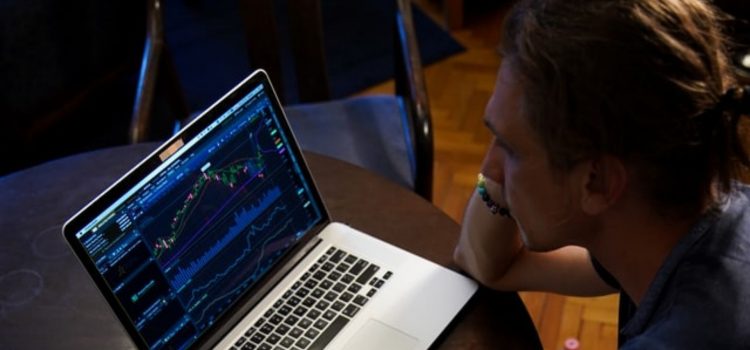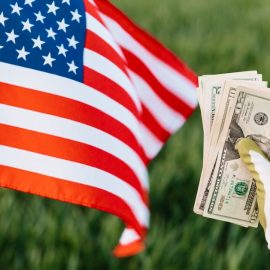

This article gives you a glimpse of what you can learn with Shortform. Shortform has the world’s best guides to 1000+ nonfiction books, plus other resources to help you accelerate your learning.
Want to learn faster and get smarter? Sign up for a free trial here .
Do you want to learn about trading psychology? What are the key psychological factors that determine trading success?
Trading is as much about your frame of mind as it is about your knowledge of the market and trading instruments. When it comes to trading psychology, the best mindset to have is one of dedication, patience, and risk tolerance. Without these attributes, you might get an occasional win, but you won’t become a consistently successful trader.
Below, we’ll talk about the psychological side of trading and why knowledge doesn’t translate into trading success.
The Psychology of Trading
According to Mark Douglas, the author of Trading in the Zone, 95% of trading errors have nothing to do with knowledge. Instead, these errors stem from our fears about losing money, being wrong, or taking profits lower than we could’ve gotten if we’d held onto an investment longer—these are all psychological factors.
Therefore, knowledge isn’t necessarily the ticket to consistent trading success. In addition to technical and financial/economic knowledge, you must master your trading psychology.
People Are Irrational Decision-Makers
Trading is ultimately all about high-stakes decision-making, and people are not fully rational decision makers—contrary to most economic and financial models.
In fact, psychological research has shown that people are irrational in systematic and predictable ways. According to psychologists Kahneman and Tversky, our irrationality stems from five key factors:
Factor #1: Overconfidence
One of the most consistent findings in psychology is that people tend to make mistakes of judgment because of an unjustified belief in their own knowledge or capacities.
The classic illustration of this cognitive bias comes from surveys that ask participants how they would rate their own driving ability. In studies focusing on college students, 80% to 90% said they were better drivers than their classmates. How, one might ask, can 90% of a population be above average?
This has important implications for trading psychology: Overconfidence affects traders as much as it does college students.
In one experiment, Kahneman asked participants to provide an estimate of the Dow Jones’s value one month from the date of the experiment. He also asked the participants to pick a high number such that they were 99% sure the Dow would be below that number a month later, and a low number such that they were 99% sure the Dow would be above that number. The upshot of the estimates was that participants were 98% sure the Dow Jones’s value would fall in between the two numbers.
The results of the experiment showed that the investors, though they were 98% sure of their estimates, were wrong 20% of the time!
In actual market behavior, overconfidence manifests itself in a number of different ways:
- Many investors, especially male investors, are confident they can beat the market, and so they trade far more frequently than they should. One study examining accounts at a discount brokerage found that the more frequently individual investors traded, the worse they did.
- Investors are prone to attributing past successes to their own savvy and past failures to bad luck—when in fact both success and failure are largely the product of chance. Recognizing the role of luck in realizing returns is key to avoiding risk.
- Investors’ overconfidence in their predictive powers leads to the general overvaluation of growth stocks. A hot new technology or app will often result in excessively optimistic growth projections—projections that frequently don’t pan out.
Factor #2: Judgment Biases
Much irrational investor behavior in the market stems from systematic cognitive biases that cloud humans’ judgment.
The Illusion of Control
One particularly problematic bias is our illusion of control: our perception that we can dictate events that are effectively random.
Price movements in the market look more or less like the results of a coin flip or “random walk.” Yet traders persist in seeing patterns in these movements—for example, hot streaks or stock “momentum”—that cause them to make bad decisions.
The “Representativeness” Heuristic
Another judgment bias that can compromise our trading success is our tendency to substitute “representativeness” or “similarity” for cool, probabilistic analysis.
A classic example concerns skyrocketing prices for a buzzy new IPO. Although the data for much-touted IPOs show mixed results, investors will look at the new hyped stock and think “Amazon” or “Facebook”—that is, their judgment will be biased toward a “representative” case that may not reflect the reality at all.
Factor #3: Herding
“Herding” (or “groupthink”) is the behavioral investing term for humans’ tendency to coalesce around a consensus judgment—even if that judgment is wrong.
One astounding study illustrates the point. In the experiment, social psychologists had a single person stand on a street corner and stare at the empty sky for exactly a minute to see how many people would stop and look also. Very few did. But when the researchers put five people on the corner, four times as many people stopped; when the researchers put 15 people on the corner, almost half of the people passing by stopped to look at the empty sky with them.
When word of mouth and media buzz tout a particular stock or industry, herd thinking can take hold, resulting in an onrush of investment and massively inflated prices. The psychologists refer to this phenomenon as the “epidemic” model—overexuberance about certain investments tends to spread like a disease.
Herd thinking can also lead to severe timing penalties. Because buzz spreads when stocks are up, investors will buy in when equities are already costly; when the prices of those equities fall, these investors are also the most likely to jump ship.
Factor #4: Loss Aversion
One of Kahneman and Tversky’s most influential discoveries is that humans mourn losses more than they relish gains. In other words, humans are naturally—and occasionally detrimentally—risk averse.
In one well-known experiment, Kahneman and Tversky offered participants a bet on a coin flip: If the coin came up heads, the subject would win $100; tails, and the subject would have to pay $100. Even though the odds of winning and losing were exactly the same—50/50—most declined to take the bet. Only when the possible winnings reached $250 (and losses reamined $100) did subjects agree to the bet. In other words, a dollar loss is 2.5x more undesirable than a dollar gain is desirable.
Associated with Kahneman and Tversky’s findings concerning loss aversion is their concept of “framing.” That is, humans’ loss aversion can increase or decrease depending on how a particular choice is worded or presented.
For example: Imagine two identical funds, Fund A and Fund B. Fund A’s prospectus describes the fund solely in terms of its risk profile and the losses it might incur; Fund B’s prospectus, on the contrary, describes the fund solely in terms of its potential returns. According to Kahneman and Tvesky’s research, even though the funds are identical, people will opt for Fund B because of how its risk is framed.
Factor #5: Pride and Regret
The natural human dispositions of pride and regret can also cause problems for traders.
On the pride side, traders are often all too happy to advertise their successes, and there’s evidence to suggest that this pride in making a winning bet leads them to make bad decisions—for example, selling a stock at a profit and incurring capital gains taxes (if the sale is made outside of a retirement account).
As far as regret goes, many people try to avoid it by holding onto losing stocks far longer than they should in the hope the stock will start rising. In a situation like this, it might actually be better to sell the stock and realize the tax deductions for the loss.
TITLE: A Random Walk Down Wall Street
AUTHOR: Burton G. Malkiel
TIME: 61
READS: 212.3
IMG_URL: https://www.shortform.com/blog/wp-content/uploads/2020/11/a-random-walk-down-wall-street-cover.png
BOOK_SUMMARYURL: a-random-walk-down-wall-street-summary-burton-g-malkiel
AMZN_ID: XYZ
Have a System in Place
To avoid falling into the trap of overconfidence, biases, or emotional trading, you must have a strict system in place—an organized, precise set of rules for identifying opportunities to buy or sell. You can purchase a system from an expert, or you can define your rules through fundamental and/or technical analysis. Whichever system you choose must have two specifications:
- Precise variables that you use to make objective decisions—The variables will tell you when you should get into the market, get out of the market, take profits, or cut losses.
- A definitive time frame for analysis—Choose a consistent time frame on which to base all of the variables you use to identify optimal points of entry and exit. This can be any time frame you want—hours, weeks, months, or years: just keep it consistent.
By creating a precise system, you’ll eliminate any need to make subjective decisions. You’ll also ensure that no extraneous variables interfere in your analysis.
Embrace Risk
Embracing risk in trading means accepting the possible outcomes of your trades without fear or regret—even negative outcomes. Remember: 95% of trading errors stem from our fears about losing money, being wrong, or selling investments prematurely and therefore missing out on maximum profits. So, to achieve consistent trading success, you need to be mostly free of fear and related emotions like anger, bitterness, and frustration.
Getting rid of fear is challenging. After all, the stakes in trading are often very high. Being wrong about a trade and losing money can cause emotional pain and financial ruin. But you need to recognize that your fears are irrational and stem largely from misguided goals that cause you to see the market as a threat. These misguided goals include fulfilling an addiction to intermittent variable rewards, impressing people in our social network, being a savior for our family, and getting a blissful high from winning.
If you’re motivated by these goals—even just a little—you’ll interpret any market information that indicates you’re wrong as painful. Why? Because by tying our happiness, fulfillment, status, and identity to positive market outcomes, you experience any indication that your goals won’t be fulfilled as a personal threat.
When we perceive the market as a threat, we’re driven by fear to do everything we can to prevent pain (by avoiding risk and losses). We’ll—consciously or unconsciously—second guess our analyses, miss prime buying moments, hesitate to take profits when we should, hold onto losing stocks way too long, and distort or ignore information that goes against our predictions. Meanwhile, opportunities to cut our losses or make money pass us by. Thus, efforts to avoid risk and pain virtually guarantee failure. Although we might achieve an occasional win, we won’t be consistent winners.
TITLE: Trading in the Zone
AUTHOR: Mark Douglas
TIME: 16
READS: 33.2
IMG_URL: https://www.shortform.com/blog/wp-content/uploads/2022/07/trading-in-the-zone-cover.png
BOOK_SUMMARYURL: trading-in-the-zone-summary-mark-douglas
AMZN_ID: XYZ
Don’t Be Put Off by Pessimism
The final aspect of trading psychology we’ll discuss is your ability to maintain an optimistic attitude. This is important because we have a natural tendency to believe financial pessimists because they tend to sound smarter and more reasonable than financial optimists. However, this is a mistake: Given our world’s history of long-term growth, the optimistic view is generally more reasonable than the pessimistic. Therefore, you must be able to evaluate financial pessimism appropriately so you don’t overreact when you encounter it.
To react appropriately to financial pessimism, you must understand why it’s so tempting. While pessimism is alluring partly due to our instinct to prioritize threats over opportunities, financial pessimism, in particular, seems especially reasonable for three main reasons:
#1: We pay more attention to bad financial news because we’re afraid that it might affect us, too.
Since our modern financial systems and economy are so interconnected, a negative event in one sector is likely to affect someone in another sector—even if those sectors aren’t related. For example, the housing market crash of 2008 didn’t just affect real estate investors; it prompted a nationwide recession that affected everyone, including people who hadn’t invested in real estate.
#2. It’s easier to make a pessimistic forecast than an optimistic one.
Many people forecast pessimistic outcomes by assuming that the current trend will continue and ignoring how the market might adapt to the world’s needs. However, extreme trends normally don’t continue because the markets adapt to extreme circumstances.
#3: It’s easier to notice negative events because they happen more suddenly.
Progress compounds slowly—over months and years, if not decades. So noticing this progress requires a lot of work: You have to pay attention to small, incremental growth over a long period of time and you have to clearly remember the state of a situation in the distant past, both of which are hard to do.
As such, most of us are slow to notice progress if we notice it at all. Conversely, destruction occurs quickly, often with just one dramatic event. As such, it captures our attention in a way that progress doesn’t.
TITLE: The Psychology of Money
AUTHOR: Morgan Housel
TIME: 52
READS: 120.4
IMG_URL: https://www.shortform.com/blog/wp-content/uploads/2022/02/the-psychology-of-money-cover.png
BOOK_SUMMARYURL: the-psychology-of-money-summary-morgan-housel
AMZN_ID: XYZ
Final Words
There is a significant psychological component to trading. In fact, when it comes to trading, psychology may be more important than knowledge of the market and trading instruments.
If you enjoyed our article about trading psychology, check out the following suggestions for further reading:
In Trading in the Zone, Mark Douglas—drawing on over two decades of experience as a trading consultant—explains how trading psychology works. He says that most people don’t succeed in trading because they embody a fear-based mindset and are too focused on avoiding risk. So, no matter how much time they spend studying the market, they fail to establish a pattern of winning. To achieve consistent success, we need to embody the winning mindset, and Douglas tells us how.
In One Up on Wall Street, Peter Lynch describes a no-nonsense approach to the stock market that involves examining your daily life for investment opportunities, doing your research, and diligently monitoring your portfolio over time. Rather than following the complex predictions of so-called professionals or leaping on the latest and greatest overpriced stock, he advises you to keep your own counsel, be self-reliant, and see yourself as your greatest resource.

Want to fast-track your learning? With Shortform, you’ll gain insights you won't find anywhere else .
Here's what you’ll get when you sign up for Shortform :
- Complicated ideas explained in simple and concise ways
- Smart analysis that connects what you’re reading to other key concepts
- Writing with zero fluff because we know how important your time is






